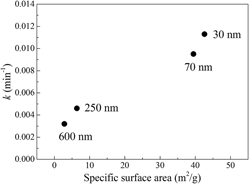Crossref Citations
This article has been cited by the following publications. This list is generated based on data provided by
Crossref.
Wan, Dong
Wang, Guanghua
Li, Wenbing
and
Wei, Xiaobi
2017.
Investigation into the morphology and structure of magnetic bentonite nanocomposites with their catalytic activity.
Applied Surface Science,
Vol. 413,
Issue. ,
p.
398.
Han, Xing
Zhang, Huanyu
Chen, Ting
Zhang, Mei
and
Guo, Min
2018.
Facile synthesis of metal-doped magnesium ferrite from saprolite laterite as an effective heterogeneous Fenton-like catalyst.
Journal of Molecular Liquids,
Vol. 272,
Issue. ,
p.
43.
Fadillah, Ganjar
Yudha, Septian Perwira
Sagadevan, Suresh
Fatimah, Is
and
Muraza, Oki
2020.
Magnetic iron oxide/clay nanocomposites for adsorption and catalytic oxidation in water treatment applications.
Open Chemistry,
Vol. 18,
Issue. 1,
p.
1148.
Nazari, Pegah
Askari, Neda
and
Rahman Setayesh, Shahrbanoo
2020.
Oxidation-precipitation of magnetic Fe3O4/AC nanocomposite as a heterogeneous catalyst for electro-Fenton treatment.
Chemical Engineering Communications,
Vol. 207,
Issue. 5,
p.
665.
Eftekhari far, Behrouz
and
Nasr‐Esfahani, Masoud
2020.
Synthesis, characterization and application of Fe3O4@SiO2@CPTMO@DEA‐SO3H nanoparticles supported on bentonite nanoclay as a magnetic catalyst for the synthesis of 1,4‐dihydropyrano[2,3‐c]pyrazoles.
Applied Organometallic Chemistry,
Vol. 34,
Issue. 3,
Rial, Juliana Belen
and
Ferreira, María Luján
2021.
Challenges of dye removal treatments based on IONzymes: Beyond heterogeneous Fenton.
Journal of Water Process Engineering,
Vol. 41,
Issue. ,
p.
102065.
Zhao, Qiang
Zhang, Congcong
Tong, Xiaoqiang
Zou, Yunling
Li, Yan
and
Wei, Fang
2021.
Fe3O4-NPs/orange peel composite as magnetic heterogeneous Fenton-like catalyst towards high-efficiency degradation of methyl orange.
Water Science and Technology,
Vol. 84,
Issue. 1,
p.
159.
SOUFI, Amal
HAJJAOUI, Hind
ELMOUBARKI, Rachid
ABDENNOURI, Mohamed
QOURZAL, Samir
and
BARKA, Noureddine
2021.
Spinel ferrites nanoparticles: Synthesis methods and application in heterogeneous Fenton oxidation of organic pollutants – A review.
Applied Surface Science Advances,
Vol. 6,
Issue. ,
p.
100145.
Zhang, Jiayu
Yan, Mingwei
Sun, Guangchao
Li, Xiang
and
Liu, Kaiqi
2021.
Visible-light photo-Fenton catalytic MgFe2O4 spinel: Reaction sintering synthesis and DFT study.
Journal of Alloys and Compounds,
Vol. 889,
Issue. ,
p.
161673.
Wang, Jianlong
and
Tang, Juntao
2021.
Fe-based Fenton-like catalysts for water treatment: Preparation, characterization and modification.
Chemosphere,
Vol. 276,
Issue. ,
p.
130177.
Fatimah, Is
Purwiandono, Gani
Sahroni, Imam
Wijayana, Adytia
Faraswati, Mediana
Dwi Putri, Annisa
Oh, Won-Chun
and
Doong, Ruey-an
2022.
Magnetically-separable photocatalyst of magnetic biochar from snake fruit peel for rhodamine B photooxidation.
Environmental Nanotechnology, Monitoring & Management,
Vol. 17,
Issue. ,
p.
100669.
Ghazzaf, H.
Nechchadi, B.
Jouali, A.
Salhi, A.
El Krati, M.
and
Tahiri, S.
2022.
Synthesis of heterogeneous photo-Fenton catalyst from iron rust and its application to degradation of Acid Red 97 in aqueous medium.
Journal of Environmental Chemical Engineering,
Vol. 10,
Issue. 3,
p.
107570.
de Oliveira Guidolin, Thays
Cechinel, Maria Alice Prado
and
Arcaro, Sabrina
2022.
Environmental Applications of Nanomaterials.
p.
133.
Che Nan, Siti Nursyamsulbahria binti
Wan Hazman, Danial
Miskon, Mohd Fuad
Abd Hamid, Shafida
Mohd. Salim, Rosliza
and
Razali, Azaima
2022.
Reduced Graphene Oxide Functionalized Magnetic Nanocomposites for Environmental Pollutant Removal.
Materials Science Forum,
Vol. 1076,
Issue. ,
p.
109.
Ayalew, Adane Adugna
2022.
A critical review on clay-based nanocomposite particles for application of wastewater treatment.
Water Science and Technology,
Vol. 85,
Issue. 10,
p.
3002.
Govindasamy, Theertharaman
Nandhakumar, Manjubaashini
Mathew, Nibin Kolanjikombil
Kulangara, Rohith Vinod
Asapu, Vinaya Kumar
Padmanapan, Saravanan
Thangaian, Daniel Thangadurai
and
Subramanian, Balakumar
2022.
Electromagnetic shielding performance of reduced graphene oxide reinforced iron oxide nanostructured materials prepared by polyol method.
Journal of Materials Research,
Vol. 37,
Issue. 6,
p.
1216.
Mabarroh, Ni'matil
Alfansuri, Taufikuddin
Aji Wibowo, Nur
Imani Istiqomah, Nurul
Marsel Tumbelaka, Rivaldo
and
Suharyadi, Edi
2022.
Detection of green-synthesized magnetite nanoparticles using spin-valve GMR-based sensor and their potential as magnetic labels.
Journal of Magnetism and Magnetic Materials,
Vol. 560,
Issue. ,
p.
169645.
Zhao, He
Zeng, Huarou
Chen, Ting
Huang, Xiaoying
Cai, Yuepeng
and
Dong, Renfeng
2023.
Catalytic micromotors as self-stirring microreactors for efficient dual-mode colorimetric detection.
Journal of Colloid and Interface Science,
Vol. 643,
Issue. ,
p.
196.
Zhu, Yanping
Xie, Qingru
Deng, Fangxin
Ni, Zhuobiao
Lin, Qingqi
Cheng, Liulong
Chen, Xiaojuan
Qiu, Rongliang
and
Zhu, Runliang
2023.
The differences in heterogeneous Fenton catalytic performance and mechanism of various iron minerals and their influencing factors: A review.
Separation and Purification Technology,
Vol. 325,
Issue. ,
p.
124702.
Hassan, Asaad F.
Mustafa, Ahmed A.
Esmail, Ghada
and
Awad, Aya M.
2023.
Adsorption and Photo-Fenton Degradation of Methylene Blue Using Nanomagnetite/Potassium Carrageenan Bio-Composite Beads.
Arabian Journal for Science and Engineering,
Vol. 48,
Issue. 1,
p.
353.



